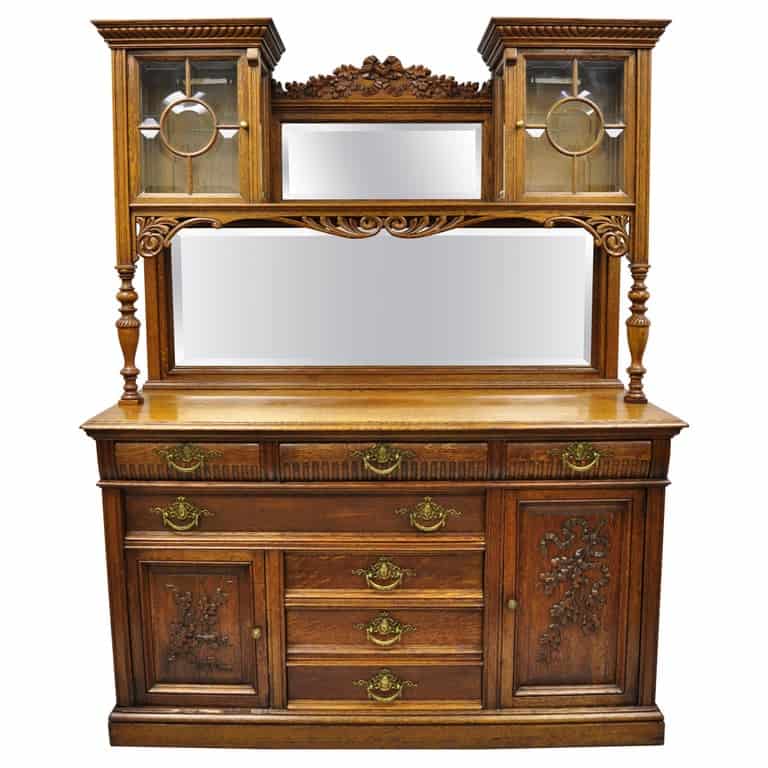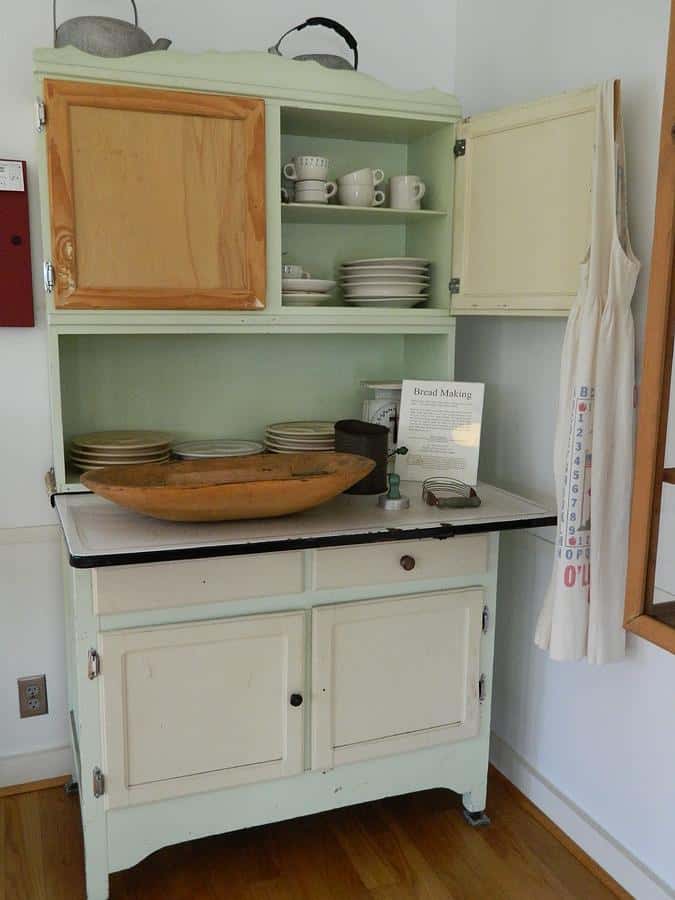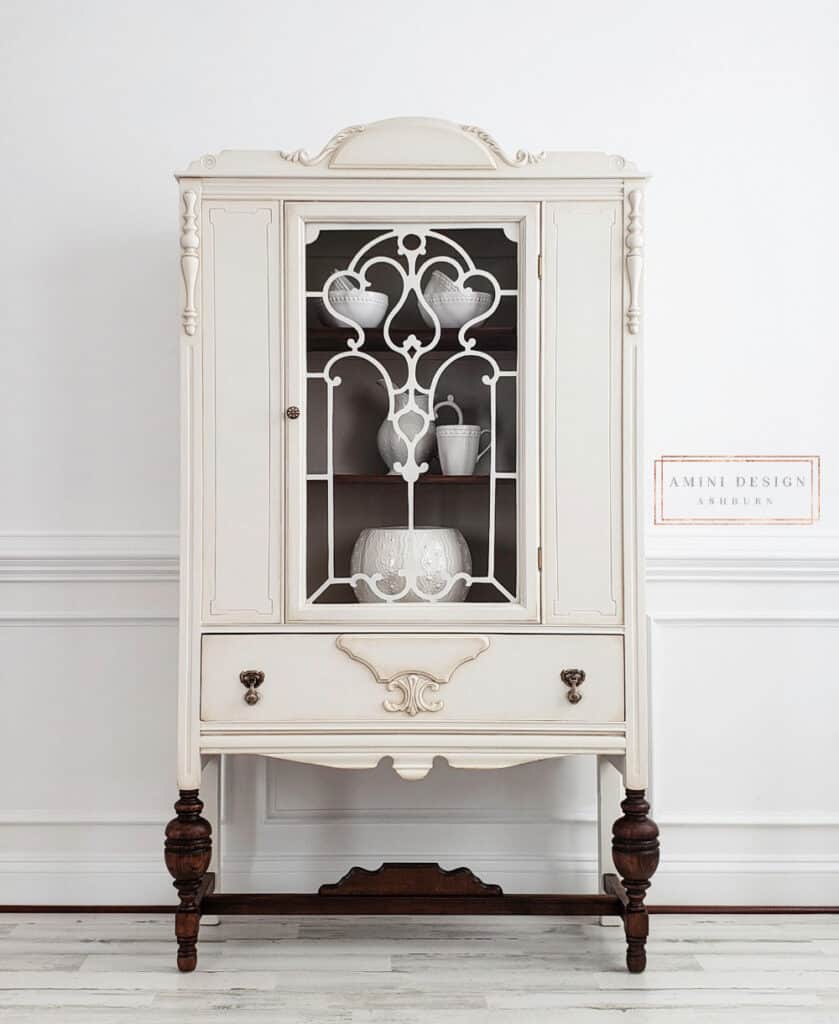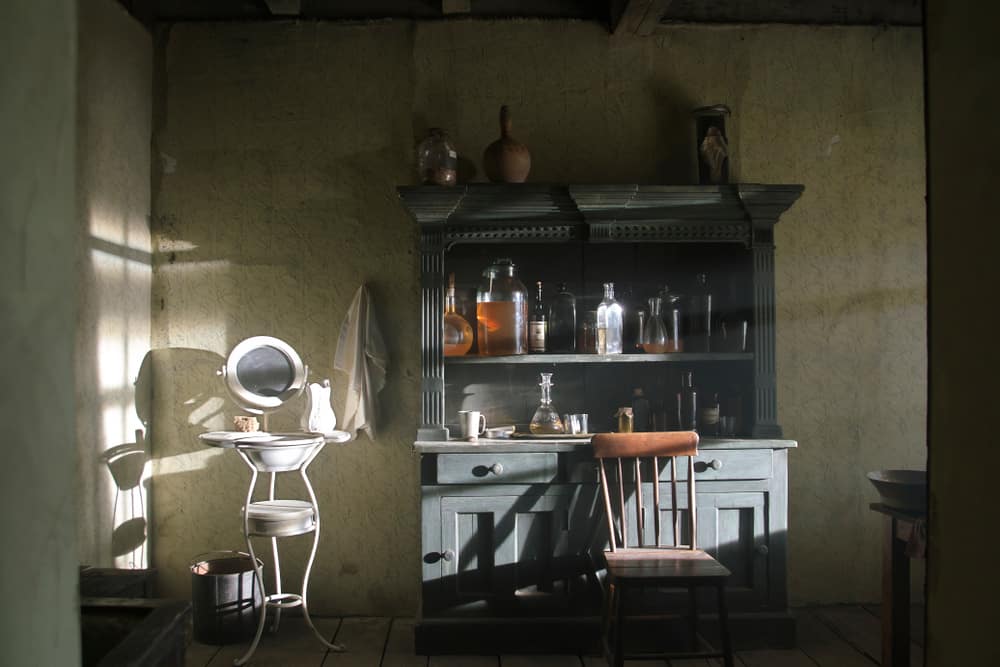Hutches are pieces of antique furniture that have a long history and have changed over time. It’s probable that they’re not as common in houses, and much less so in apartments, because contemporary life has forced us to live in smaller areas, where space for these enormous dressers is rare.
Furthermore, it was used to buy and keep this furniture centuries ago to store the sets of dishes that upper and middle-class families had.
This made sense because, many years ago, it was normal to invite friends and entertain them with large dinners, requiring the use of whole sets of crockery, and the hutch was the ideal piece of furniture for properly storing all of the dinnerware.
That is no longer a custom, but that does not imply the hutches have lost their charm and appeal.
They’re becoming increasingly popular and selling well on the vintage market and through internet auctions.
If you’re considering buying one or selling the one you got from your grandparents, we recommend reading this article first. It will teach you everything you need to know about ancient hutches, their different kinds, how to identify them, and how to value them when selling or buying one.
Table of Contents
A little bit of History
Hutches are pieces of furniture that have been around for a long time. But they are pretty new when compared to other antiques.
Its fame immediately extended across Europe and then to the American continent, where it grew in popularity, particularly in the United States.
Hutches are also Chinese Hutches or porcelain cabinets since they were originally used to hold sets of dishes. Most families in the period spent money on a set of Chinese dinnerware to impress guests and have big gatherings.
That is why many people believe these sideboards were constructed in China; nevertheless, nothing could be further from the truth; they were given that name since it was very typical for each household’s Chinese tableware to be kept inside the cabinets.
They were first created in England at the end of the 17th century, and their popularity grew during the 18th. Following its widespread acceptance in England, the trend spread to the Netherlands and, as a result, to the rest of Europe.
Having a Hutch at home was a sign of wealth and provided the middle classes a certain status, as they did not always have the financial capacity to invest in china dishware and a cabinet to display it.
In the United States, they were very popular and cities like New York, Philadelphia, and Virginia specialized in their manufacture.
Chippendale and Queen Anne styles were popular, and each region developed its design.
EA Clore was a well-known and famous furniture maker that still produces furniture today.
At the beginning of the 20th century, they experienced a resurgence in America, with the waves of immigrants, Italians, English, and French who arrived to fight for the “American Dream”. This great migration of Europeans brought with it new styles since the immigrants used the designs of each country but with new modifications.
Hutches are still created for a variety of uses today, and they are known for their simplicity and a great capacity for storing dishes. Manufacturers like Pulaski Furniture, Howard Miller Company, and Besset continue to produce high-quality Hutches that are in high demand.
Antique Hutch Styles
Hutches were built in many sizes, shapes, and for various purposes due to their widespread appeal, but among the huge diversity, we may name three types of hutches that are used for certain purposes and have been established over time
Antique Buffet Hutch

It’s the most basic of all the hutches. Its name comes from the fact that it was used not just to keep plates and tableware, but also to serve meals, prepare drinks, and put up buffet-style food.
Some types are supplied with wheels and an open shelf for a more practical purpose, and this provides the furniture with great practicality because it is not compelled to be just in the dining room, but can be moved and adapted to your needs.
Antique Kitchen Hutch

It looks quite similar to a buffet hutch, but it has a much bigger upper half and is a more solid piece of furniture in general.
The upper shelves not only offer a place to keep the crockery, but it also includes a kind of shelf where you can store a lot more cooking utensils.
They are currently in high demand because the top space and their awesome hardware are being used to decorate with vases, ornaments, or even as a bookshelf.
Buffet hutches differ in several ways, including the lack of wheels and the fact that they are significantly larger and heavier.
It has a huge flat top that may be used as a table and several useful drawers and compartments underneath. They are typically built of wood, although some include small glass windows to allow light into the interior.
Another significant difference is that the majority of the top doors have only a wooden frame and glass doors.
These cabinet doors make it ideal for displaying all that is within, which is why interior designers favor them when incorporating them into a design scheme.
Antique Chinese Hutch

This is the largest of all the hutches, commonly known as the ‘Welsh Dresser.’ Because the objective was to show off the tableware and utensils kept inside, all of the designs are created with hardwood doors but with glass panels.
The lower section has solid wooden doors that, unlike the upper section, do not reveal the inside. Some of these hutches have rectangular drawers, similar to those found in quarter dressers.
You should bear in mind that, in addition to these three types of hutches, you can find them in a variety of artistic styles depending on the era to which they belong.
Many people nowadays choose to renovate this heavy furniture and include it in their current home decor.
There are also very accurate replicas of English, French, Swedish, Dutch, American, Victorian era, or the popular Queen Anne style available.
How do I identify my antique hutch?
Even expert collectors find it difficult to recognize these pieces of furniture, but a few indicators can help those new to the game and want to know if their Hutch is old or worth something.
Pay attention to the materials used in construction
Because most historic Hutches were made of hardwood, the following are the types of wood that were used to construct them:
Maple\Oak\Mahogany\Walnut\Cherry/Pine
The interior of the dinnerware housed in the Hutch is usually visible through glass panels on most of these hutches. Keep in mind that this was the furniture’s purpose.
Mirrors placed on the internal sides of the furniture are also fairly popular in antique replicas.
You will observe that most antique designs are relatively simple; however, this does not mean that a piece of furniture richly decorated with carvings and detailing is false.
Take into consideration the various styles
Hutches have been the heroes of several styles for their fabrication for more than a century due to their popularity.
If you notice the stamps or autographs of manufacturers like Chippendale or Sheraton, you know you’re dealing with an authentic piece.
It will also assist you in remembering the various styles in which this furniture can be found: Victorian, Queen Anne, and Mission. Keep in mind the influence of many countries and their styles, such as English, American, Swedish, and French.
Finally, here are some tips to assist you to identify an antique hutch:
- Always search for an identifying symbol on the furniture, such as a manufacturer’s stamp or production date. There are books, guides, and websites that include archives of old marks that can assist you in determining which one is on your furniture.
- A rough and bad finish, as well as a pungent stench, can be found on the Hutch’s outside surface. The majority of real hutches are also of a drab tone. All of this is due to the old oil varnishes that were used to protect the wood on the furniture.
- Because of the lack of technology at the time, the furniture should have markings and defects in specific areas, particularly in the wood joints.
- Finally, look at the wood’s condition; if your furniture is quite old, it should have some form of damage from the passage of time.
Is there any value in antique hutches?
These antiques are extremely valuable, and if they are in good shape and are original to a specific era or style, they can be extremely valuable.
It’s important to remember that these were incredibly big and complicated pieces to make, and their quality was guaranteed. Anyone who purchased a Hutch understood he was making a long-term investment, as the furniture was meant to last for many years.
The fact that some of these sideboards are hundreds of years old and yet stand and are completely functioning is proof of this.
One of these pieces of furniture won’t be under $10,000, but keep in mind that it’s a product that will last a lifetime. There are other less expensive replicas available, roughly half the price listed above, but they are considerably simpler and smaller.
If you encounter a large Hutch for $5,000 or less, it’s probably a modern reproduction or a genuine item with too many modern adjustments.
We’ve included a list of Hutches for sale on our online antique website below, so you can get a sense of prices, sizes, and types. We’ll go from the most expensive and antique to the smaller and more current models.
- EJ Victor Inlaid Satinwood & Mahogany Breakfront China Cabinet — US $16,342.00
- Baker Stately Homes Monumental Mahogany Breakfront — US $12,500.00
- Antique Hand Carved Oak Dry Bar Chinese Oak Marble Dry Server Cabinet — USD 10,500.00
- PIECE OF HOLDER SOLD / Black and sage green painted antique round top porcelain cabinet hutch / Distressed black painted furniture cabinet — $10,143.51
- Antique Chinoiserie Black Gold Lacquer Secretary Desk — $7,800.00
- 19th Century English Quarter-Sawn Oak Welsh Dresser Style Step-Back Cupboard — the US $6,390.00
- French Antique Normandy Oak Louis XV Buffet / Hutch 18th Century — $6,200.00
- John Widdicomb Oak Welsh Dresser Style Step-Back Cupboard — US $5,950.00
- Antique Victorian Breakfront Mahogany China Cabinet Carved Hutch Armoire c.1880 — US $5,800.00
- Antique French Oak Louis XIII Hunt Scene Buffet / Server / Sideboard with Hutch — $4,250.00
Antique Hutch Repurposed
Even if you have an antique hutch and don’t want it to lose its worth, you shouldn’t let the wood rot or deteriorate.
If repairs or modifications are required, go ahead and do it without fear, but always seek professional advice to determine the best approach to restore your Hutch without losing its value.
Likewise, you are not required to use it for the same purposes for which it was designed.
You might not have a complete set of bone china at home, but that doesn’t mean you can’t put your Hutch to good use.
Adapt the Hutch to your modern demands by being inventive. If you’re an athlete, for example, and you want to brag about your medals and accomplishments, the Hutch is a great location to display your medals, trophies, and other athletic awards.
You can also fill it with photos of your children, grandchildren, cousins, or loved ones who are no longer with you to create a wonderful family memory.
You may even use it to display your book collection by utilizing the shelves. However, we recommend that you always assess the weight that the shelves can sustain, as putting too much weight on top of them can cause them to collapse; keep in mind that they were created for dinnerware storage.
Finally, be sure to hire someone who can restore the hutch without losing its historical value, as many restorers advertise themselves with fantastic prices and complete restoration, but many times this is not the best option.
By completely restoring it, you will lose much of its value, so seek advice from people who can make your Hutch a functional piece of furniture while preserving its historical value.
Final Words
We hope that this guide has helped you to understand the value that an old Hutch can have and the uses that you can still give it in these modern times.
Remember that if you want to sell your old Hutch or buy one at an auction or online store, it is advisable that you first study the styles and consult professionals who can give you a better idea of the correct value of each piece.
